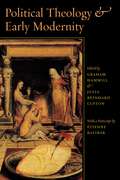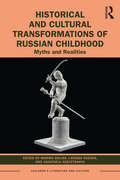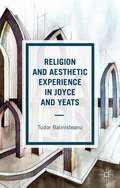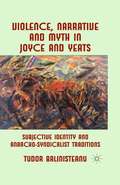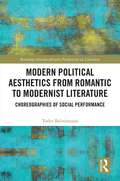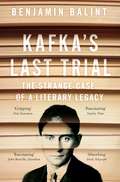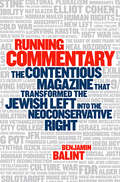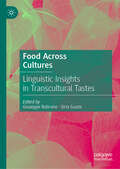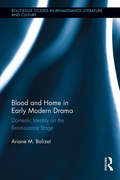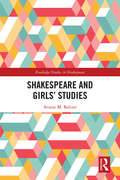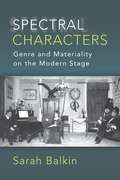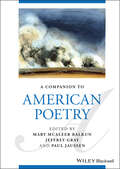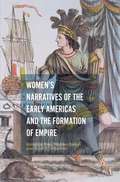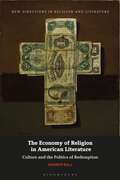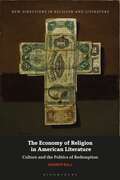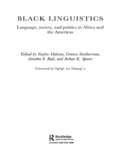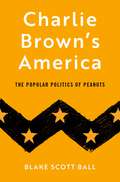- Table View
- List View
Political Theology and Early Modernity
by Étienne BalibarPolitical theology is a distinctly modern problem, one that takes shape in some of the most important theoretical writings of the twentieth and twenty-first centuries. But its origins stem from the early modern period, in medieval iconographies of sacred kinship and the critique of traditional sovereignty mounted by Hobbes and Spinoza. In this book, Graham Hammill and Julia Reinhard Lupton assemble established and emerging scholars in early modern studies to examine the role played by sixteenth- and seventeenth-century literature and thought in modern conceptions of political theology. Political Theology and Early Modernity explores texts by Shakespeare, Machiavelli, Milton, and others that have served as points of departure for such thinkers as Schmitt, Strauss, Benjamin, and Arendt. Written from a spectrum of positions ranging from renewed defenses of secularism to attempts to reconceive the religious character of collective life and literary experience, these essays probe moments of productive conflict, disavowal, and entanglement in politics and religion as they pass between early modern and modern scenes of thought. This stimulating collection is the first to answer not only how Renaissance and baroque literature help explain the persistence of political theology in modernity and postmodernity, but also how the reemergence of political theology as an intellectual and political problem deepens our understanding of the early modern period.
Historical and Cultural Transformations of Russian Childhood: Myths and Realities (Children's Literature and Culture)
by Marina Balina Larissa Rudova Anastasia KostetskayaHistorical and Cultural Transformations of Russian Childhood is a collection of multidisciplinary scholarly essays on childhood experience. The volume offers new critical approaches to Russian and Soviet childhood at the intersection of philosophy, literary criticism, film/visual studies, and history. Pedagogical ideas and practices, and the ideological and political underpinnings of the experience of growing up in pre-revolutionary Russia, the Soviet Union, and Putin’s contemporary Russia are central venues of analysis. Toward the goal of constructing the "multimedial childhood text," the contributors tackle issues of happiness and trauma associated with childhood and foreground its fluidity and instability in the Russian context. The volume further examines practices of reading childhood: as nostalgic text, documentary evidence, and historic mythology. Considering Russian childhood as historical documentation or fictional narrative, as an object of material culture, and as embodied in different media (periodicals, visual culture, and cinema), the volume intends to both problematize but also elucidate the relationship between childhood, history, and various modes of narrativity.
Historical and Cultural Transformations of Russian Childhood: Myths and Realities (Children's Literature and Culture)
by Marina Balina Larissa Rudova Anastasia KostetskayaHistorical and Cultural Transformations of Russian Childhood is a collection of multidisciplinary scholarly essays on childhood experience. The volume offers new critical approaches to Russian and Soviet childhood at the intersection of philosophy, literary criticism, film/visual studies, and history. Pedagogical ideas and practices, and the ideological and political underpinnings of the experience of growing up in pre-revolutionary Russia, the Soviet Union, and Putin’s contemporary Russia are central venues of analysis. Toward the goal of constructing the "multimedial childhood text," the contributors tackle issues of happiness and trauma associated with childhood and foreground its fluidity and instability in the Russian context. The volume further examines practices of reading childhood: as nostalgic text, documentary evidence, and historic mythology. Considering Russian childhood as historical documentation or fictional narrative, as an object of material culture, and as embodied in different media (periodicals, visual culture, and cinema), the volume intends to both problematize but also elucidate the relationship between childhood, history, and various modes of narrativity.
Religion and Aesthetic Experience in Joyce and Yeats
by T. BalinisteanuThis monograph is based on archival research and close readings of James Joyce's and W. B. Yeats's poetics and political aesthetics. Georges Sorel's theory of social myth is used as a starting point for exploring the ways in which the experience of art can be seen as a form of religious experience.
Violence, Narrative and Myth in Joyce and Yeats: Subjective Identity and Anarcho-Syndicalist Traditions
by T. BalinisteanuHow can we use art to reconstruct ourselves and the material world? Is every individual an art object? Is the material world an art text? This book answers these questions by examining modernist literature, especially James Joyce and W.B. Yeats, in the context of anarchist intellectual thought and Georges Sorel's theory of social myth.
Modern Political Aesthetics from Romantic to Modernist Fiction: Choreographies of Social Performance (Routledge Interdisciplinary Perspectives On Literature Ser.)
by Tudor BalinisteanuIn this new research monograph, Tudor Balinsteanu draws on concepts of dance to demonstrate how the nonhuman is dealt with in terms of practical politics, that is, choreographies of social performance which emerge at the intersection of literature, art, and embodied life. Drawing on a number of influential texts by William Wordsworth, Joseph Conrad, W. B. Yeats, and James Joyce, this truly interdisciplinary monograph explores the relations between the human and the nonhuman across centuries of literature and as demonstrated in philosophical concepts and social experiments.
Modern Political Aesthetics from Romantic to Modernist Fiction: Choreographies of Social Performance
by Tudor BalinisteanuIn this new research monograph, Tudor Balinsteanu draws on concepts of dance to demonstrate how the nonhuman is dealt with in terms of practical politics, that is, choreographies of social performance which emerge at the intersection of literature, art, and embodied life. Drawing on a number of influential texts by William Wordsworth, Joseph Conrad, W. B. Yeats, and James Joyce, this truly interdisciplinary monograph explores the relations between the human and the nonhuman across centuries of literature and as demonstrated in philosophical concepts and social experiments.
Kafka's Last Trial: The Case of a Literary Legacy
by Benjamin Balint'Fascinating and forensically scrupulous.' John Banville, GuardianWhen Franz Kafka died in 1924, his loyal champion Max Brod could not bring himself to fulfil his friend’s last instruction: to burn his remaining manuscripts. Instead, Brod devoted the rest of his life to editing, publishing and canonizing Kafka’s work. By betraying his friend’s last wish, Brod twice rescued his legacy – first from physical destruction, and then from obscurity. But that betrayal was also eventually to lead to an international legal battle: as a writer in German, should Kafka’s papers come to rest in Germany, where his three sisters died as victims of the Holocaust? Or, as a Jewish writer, should his work be considered as a cultural inheritance of Israel, a state that did not exist at the time of his death?Alongside an acutely observed portrait of Kafka, Benjamin Balint also traces the journey of the manuscripts Brod had rescued when he fled from Prague to Palestine in 1939 and offers a gripping account of the Israeli court case that determined their fate. He tells of a wrenching escape from the Nazi invaders of Czechoslovakia; of a love affair between exiles stranded in Tel Aviv; and of two countries whose national obsessions with the past eventually faced off in the courts. For fans of Philippe Sands' East West Street, in Kafka’s Last Trial Benjamin Balint invites us to consider Kafka’s remarkable legacy and to question whether that legacy belongs by right to the country of his language, that of his birth, or that of his cultural affinities – but also whether any nation state can lay claim to ownership of a writer’s work at all.
Running Commentary: The Contentious Magazine that Transformed the Jewish Left into the Neoconservative Right
by Benjamin BalintIn the years of cultural and political ferment following World War II, a new generation of Jewish- American writers and thinkers arose to make an indelible mark on American culture. Commentary was their magazine; the place where they and other politically sympathetic intellectuals-Hannah Arendt, Saul Bellow, Lionel Trilling, Alfred Kazin, James Baldwin, Bernard Malamud, Philip Roth, Cynthia Ozick and many others-shared new work, explored ideas, and argued with each other.Founded by the offspring of immigrants, Commentary began life as a voice for the marginalized and a feisty advocate for civil rights and economic justice. But just as American culture moved in its direction, it began-inexplicably to some-to veer right, becoming the voice of neoconservativism and defender of the powerful.This lively history, based on unprecedented access to the magazine's archives and dozens of original interviews, provocatively explains that shift while recreating the atmosphere of some of the most exciting decades in American intellectual life.
Running Commentary: The Contentious Magazine that Transformed the Jewish Left into the Neoconservative Right
by Benjamin BalintIn the years of cultural and political ferment following World War II, a new generation of Jewish- American writers and thinkers arose to make an indelible mark on American culture. Commentary was their magazine; the place where they and other politically sympathetic intellectuals -- Hannah Arendt, Saul Bellow, Lionel Trilling, Alfred Kazin, James Baldwin, Bernard Malamud, Philip Roth, Cynthia Ozick and many others -- shared new work, explored ideas, and argued with each other. Founded by the offspring of immigrants, Commentary began life as a voice for the marginalized and a feisty advocate for civil rights and economic justice. But just as American culture moved in its direction, it began -- inexplicably to some -- to veer right, becoming the voice of neoconservativism and defender of the powerful. This lively history, based on unprecedented access to the magazine's archives and dozens of original interviews, provocatively explains that shift while recreating the atmosphere of some of the most exciting decades in American intellectual life.
Food Across Cultures: Linguistic Insights in Transcultural Tastes
by Giuseppe Balirano Siria GuzzoThis edited volume brings together original sociolinguistic and cultural contributions on food as an instrument to explore diasporic identities. Focusing on food practices in cross-cultural contact, the authors reveal how they can be used as a powerful vehicle for positive intercultural exchange either though conservation and the maintenance of cultural continuity, or through hybridization and the means through which migrant communities find compromise, or even consent, within the host community. Each chapter presents a fascinating range of data and new perspectives on cultures and languages in contact: from English (and some of its varieties) to Italian, German, Spanish, and to Japanese and Palauan, as well as an exemplary range of types of contact, in colonial, multicultural, and diasporic situations. The authors use a range of integrated approaches to examine how socio-linguistic food practices can, and do, contribute to identity construction in diverse transnational and diasporic contexts. The book will be of particular interest to students and scholars of translation, semiotics, cultural studies and sociolinguistics.
Blood and Home in Early Modern Drama: Domestic Identity on the Renaissance Stage (Routledge Studies in Renaissance Literature and Culture)
by Ariane M. BalizetIn this volume, the author argues that blood was, crucially, a means by which dramatists negotiated shifting contours of domesticity in 16th and 17th century England. Early modern English drama vividly addressed contemporary debates over an expanding idea of "the domestic," which encompassed the domus as well as sex, parenthood, household order, the relationship between home and state, and the connections between family honor and national identity. The author contends that the domestic ideology expressed by theatrical depictions of marriage and household order is one built on the simultaneous familiarity and violence inherent to blood. The theatrical relation between blood and home is far more intricate than the idealized language of the familial bloodline; the home was itself a bloody place, with domestic bloodstains signifying a range of experiences including religious worship, sex, murder, birth, healing, and holy justice. Focusing on four bleeding figures—the Bleeding Bride, Bleeding Husband, Bleeding Child, and Bleeding Patient—the author argues that the household blood of the early modern stage not only expressed the violence and conflict occasioned by domestic ideology, but also established the home as a site that alternately reified and challenged patriarchal authority.
Blood and Home in Early Modern Drama: Domestic Identity on the Renaissance Stage (Routledge Studies in Renaissance Literature and Culture)
by Ariane M. BalizetIn this volume, the author argues that blood was, crucially, a means by which dramatists negotiated shifting contours of domesticity in 16th and 17th century England. Early modern English drama vividly addressed contemporary debates over an expanding idea of "the domestic," which encompassed the domus as well as sex, parenthood, household order, the relationship between home and state, and the connections between family honor and national identity. The author contends that the domestic ideology expressed by theatrical depictions of marriage and household order is one built on the simultaneous familiarity and violence inherent to blood. The theatrical relation between blood and home is far more intricate than the idealized language of the familial bloodline; the home was itself a bloody place, with domestic bloodstains signifying a range of experiences including religious worship, sex, murder, birth, healing, and holy justice. Focusing on four bleeding figures—the Bleeding Bride, Bleeding Husband, Bleeding Child, and Bleeding Patient—the author argues that the household blood of the early modern stage not only expressed the violence and conflict occasioned by domestic ideology, but also established the home as a site that alternately reified and challenged patriarchal authority.
Shakespeare and Girls’ Studies (Routledge Studies in Shakespeare)
by Ariane M. BalizetA modern-day Taming of the Shrew that concludes at a high school prom. An agoraphobic Olivia from Twelfth Night sending video dispatches from her bedroom. A time-traveling teenager finding romance in the house of Capulet. Shakespeare and Girls’ Studies posits that Shakespeare in popular culture is increasingly becoming the domain of the adolescent girl, and engages the interdisciplinary field of Girls’ Studies to analyze adaptation and appropriation of Shakespeare’s plays in the late 20th and early 21st centuries. Through chapters on film, television, young adult fiction, and web series aimed at girl readers and audiences, this volume explores the impact of girl cultures and concerns on Shakespeare’s afterlife in popular culture and the classroom. Shakespeare and Girls’ Studies argues that girls hold a central place in Shakespearean adaptation, and that studying Shakespeare through the lens of contemporary girlhoods can generate new approaches to Renaissance literature as well as popular culture aimed at girls and young people of marginalized genders. Drawing on contemporary cultural discourses ranging from Abstinence-Only Sex Education and Shakespeare in the US Common Core to rape culture and coming out, this book addresses the overlap between Shakespeare’s timeless girl heroines and modern popular cultures that embrace figures like Juliet and Ophelia to understand and validate the experiences of girls. Shakespeare and Girls’ Studies theorizes Shakespeare’s past and present cultural authority as part of an intersectional approach to adaptation in popular culture.
Shakespeare and Girls’ Studies (Routledge Studies in Shakespeare)
by Ariane M. BalizetA modern-day Taming of the Shrew that concludes at a high school prom. An agoraphobic Olivia from Twelfth Night sending video dispatches from her bedroom. A time-traveling teenager finding romance in the house of Capulet. Shakespeare and Girls’ Studies posits that Shakespeare in popular culture is increasingly becoming the domain of the adolescent girl, and engages the interdisciplinary field of Girls’ Studies to analyze adaptation and appropriation of Shakespeare’s plays in the late 20th and early 21st centuries. Through chapters on film, television, young adult fiction, and web series aimed at girl readers and audiences, this volume explores the impact of girl cultures and concerns on Shakespeare’s afterlife in popular culture and the classroom. Shakespeare and Girls’ Studies argues that girls hold a central place in Shakespearean adaptation, and that studying Shakespeare through the lens of contemporary girlhoods can generate new approaches to Renaissance literature as well as popular culture aimed at girls and young people of marginalized genders. Drawing on contemporary cultural discourses ranging from Abstinence-Only Sex Education and Shakespeare in the US Common Core to rape culture and coming out, this book addresses the overlap between Shakespeare’s timeless girl heroines and modern popular cultures that embrace figures like Juliet and Ophelia to understand and validate the experiences of girls. Shakespeare and Girls’ Studies theorizes Shakespeare’s past and present cultural authority as part of an intersectional approach to adaptation in popular culture.
Spectral Characters: Genre and Materiality on the Modern Stage
by Sarah BalkinTheater’s materiality and reliance on human actors has traditionally put it at odds with modernist principles of aesthetic autonomy and depersonalization. Spectral Characters argues that modern dramatists in fact emphasized the extent to which humans are fictional, made and changed by costumes, settings, props, and spoken dialogue. Examining work by Ibsen, Wilde, Strindberg, Genet, Kopit, and Beckett, the book takes up the apparent deadness of characters whose selves are made of other people, whose thoughts become exteriorized communication technologies, and whose bodies merge with walls and furniture. The ghostly, vampiric, and telepathic qualities of these characters, Sarah Balkin argues, mark a new relationship between the material and the imaginary in modern theater. By considering characters whose bodies respond to language, whose attempts to realize their individuality collapse into inanimacy, and who sometimes don’t appear at all, the book posits a new genealogy of modernist drama that emphasizes its continuities with nineteenth-century melodrama and realism.
A Companion to American Poetry (Blackwell Companions to Literature and Culture)
by Mary McAleer Balkun Jeffrey H. Gray Paul JaussenA COMPANION TO AMERICAN POETRY A COMPANION TO AMERICAN POETRY A Companion to American Poetry brings together original essays by both established scholars and emerging critical voices to explore the latest topics and debates in American poetry and its study. Highlighting the diverse nature of poetic practice and scholarship, this comprehensive volume addresses a broad range of individual poets, movements, genres, and concepts from the seventeenth century to the present day. Organized thematically, the Companion’s thirty-seven chapters address a variety of emerging trends in American poetry, providing historical context and new perspectives on topics such as poetics and identity, poetry and the arts, early and late experimentalisms, poetry and the transcendent, transnational poetics, poetry of engagement, poetry in cinema and popular music, Queer and Trans poetics, poetry and politics in the 21st century, and African American, Asian American, Latinx, and Indigenous poetries. Both a nuanced survey of American poetry and a catalyst for future scholarship, A Companion to American Poetry is essential reading for advanced undergraduate and graduate students, academic researchers and scholars, and general readers with interest in current trends in American poetry.
A Companion to American Poetry (Blackwell Companions to Literature and Culture)
by Mary Mcaleer Balkun Jeffrey Gray Paul JaussenA COMPANION TO AMERICAN POETRY A COMPANION TO AMERICAN POETRY A Companion to American Poetry brings together original essays by both established scholars and emerging critical voices to explore the latest topics and debates in American poetry and its study. Highlighting the diverse nature of poetic practice and scholarship, this comprehensive volume addresses a broad range of individual poets, movements, genres, and concepts from the seventeenth century to the present day. Organized thematically, the Companion’s thirty-seven chapters address a variety of emerging trends in American poetry, providing historical context and new perspectives on topics such as poetics and identity, poetry and the arts, early and late experimentalisms, poetry and the transcendent, transnational poetics, poetry of engagement, poetry in cinema and popular music, Queer and Trans poetics, poetry and politics in the 21st century, and African American, Asian American, Latinx, and Indigenous poetries. Both a nuanced survey of American poetry and a catalyst for future scholarship, A Companion to American Poetry is essential reading for advanced undergraduate and graduate students, academic researchers and scholars, and general readers with interest in current trends in American poetry.
Women’s Narratives of the Early Americas and the Formation of Empire
by Mary McAleer Balkun Susan C. ImbarratoThe essays in this collection examine the connections between the forces of empire and women's lives in the early Americas, in particular the ways their narratives contributed to empire formation. Focusing on the female body as a site of contestation, the essays describe acts of bravery, subversion, and survival expressed in a variety of genres, including the saga, letter, diary, captivity narrative, travel narrative, verse, sentimental novel, and autobiography. The volume also speaks to a range of female experience, across the Americas and across time, from the Viking exploration to early nineteenth-century United States, challenging scholars to reflect on the implications of early American literature even to the present day.
The Economy of Religion in American Literature: Culture and the Politics of Redemption (New Directions in Religion and Literature)
by Andrew BallOffering a thorough reassessment of modern American culture, this book examines how economic change influences religion, and the way literature mediates that influence. Focusing on the period 1840-1940, this book shows how the development of capitalism reshaped American Protestantism and addresses the necessary role of literature in that process. Arguing that the “spirit of capitalism” was not fostered by traditional Puritanism, but rather that Christianity was transformed by the Market and Industrial Revolutions, this book refutes the long-held secularization thesis by showing that modernity was a time when new forms of the sacred proliferated, and that this religious flourishing was essential to the production of American culture. It draws from the work of Émile Durkheim and cultural sociology to interpret modern social upheavals like religious awakenings, revivalism, and the labor movement. Examining work from writers like Rebecca Harding Davis, Jack London, and Countee Cullen, it shows how concepts of salvation fundamentally intersect with matters of race, gender, and class, and proposes a theory that explains the enchantment of modern American society.
The Economy of Religion in American Literature: Culture and the Politics of Redemption (New Directions in Religion and Literature)
by Andrew BallOffering a thorough reassessment of modern American culture, this book examines how economic change influences religion, and the way literature mediates that influence. Focusing on the period 1840-1940, this book shows how the development of capitalism reshaped American Protestantism and addresses the necessary role of literature in that process. Arguing that the “spirit of capitalism” was not fostered by traditional Puritanism, but rather that Christianity was transformed by the Market and Industrial Revolutions, this book refutes the long-held secularization thesis by showing that modernity was a time when new forms of the sacred proliferated, and that this religious flourishing was essential to the production of American culture. It draws from the work of Émile Durkheim and cultural sociology to interpret modern social upheavals like religious awakenings, revivalism, and the labor movement. Examining work from writers like Rebecca Harding Davis, Jack London, and Countee Cullen, it shows how concepts of salvation fundamentally intersect with matters of race, gender, and class, and proposes a theory that explains the enchantment of modern American society.
Black Linguistics: Language, Society and Politics in Africa and the Americas
by Arnetha Ball Sinfree Makoni Geneva Smitherman Arthur K. Spears Forward by wa Thiong'oEnslavement, forced migration, war and colonization have led to the global dispersal of Black communities and to the fragmentation of common experiences.The majority of Black language researchers explore the social and linguistic phenomena of individual Black communities, without looking at Black experiences outside a given community. This groundbreaking collection re-orders the elitist and colonial elements of language studies by drawing together the multiple perspectives of Black language researchers. In doing so, the book recognises and formalises the existence of a "Black Linguistic Perspective" highlights the contributions of Black language researchers in the field.Written exclusively by Black scholars on behalf of, and in collaboration with local communities, the book looks at the commonalities and differences among Black speech communities in Africa and the Diaspora. Topics include:* the OJ Simpson trial* language issues in Southern Africa and Francophone West Africa* the language of Hip Hop* the language of the Rastafaria in JamaicaWith a foreword by Ngugi wa Thiong'o, this is essential reading for anyone with an interest in the linguistic implications of colonization.
Black Linguistics: Language, Society and Politics in Africa and the Americas
by Arnetha Ball Sinfree Makoni Geneva Smitherman Arthur K. Spears Forward by wa Thiong'oEnslavement, forced migration, war and colonization have led to the global dispersal of Black communities and to the fragmentation of common experiences.The majority of Black language researchers explore the social and linguistic phenomena of individual Black communities, without looking at Black experiences outside a given community. This groundbreaking collection re-orders the elitist and colonial elements of language studies by drawing together the multiple perspectives of Black language researchers. In doing so, the book recognises and formalises the existence of a "Black Linguistic Perspective" highlights the contributions of Black language researchers in the field.Written exclusively by Black scholars on behalf of, and in collaboration with local communities, the book looks at the commonalities and differences among Black speech communities in Africa and the Diaspora. Topics include:* the OJ Simpson trial* language issues in Southern Africa and Francophone West Africa* the language of Hip Hop* the language of the Rastafaria in JamaicaWith a foreword by Ngugi wa Thiong'o, this is essential reading for anyone with an interest in the linguistic implications of colonization.
Charlie Brown's America: The Popular Politics of Peanuts
by Blake Scott BallDespite--or because of--its huge popular culture status, Peanuts enabled cartoonist Charles Schulz to offer political commentary on the most controversial topics of postwar American culture through the voices of Charlie Brown, Snoopy, and the Peanuts gang. In postwar America, there was no newspaper comic strip more recognizable than Charles Schulz's Peanuts. It was everywhere, not just in thousands of daily newspapers. For nearly fifty years, Peanuts was a mainstay of American popular culture in television, movies, and merchandising, from the Macy's Thanksgiving Day Parade to the White House to the breakfast table. Most people have come to associate Peanuts with the innocence of childhood, not the social and political turmoil of the 1960s and 1970s. Some have even argued that Peanuts was so beloved because it was apolitical. The truth, as Blake Scott Ball shows, is that Peanuts was very political. Whether it was the battles over the Vietnam War, racial integration, feminism, or the future of a nuclear world, Peanuts was a daily conversation about very real hopes and fears and the political realities of the Cold War world. As thousands of fan letters, interviews, and behind-the-scenes documents reveal, Charles Schulz used his comic strip to project his ideas to a mass audience and comment on the rapidly changing politics of America. Charlie Brown's America covers all of these debates and much more in a historical journey through the tumultuous decades of the Cold War as seen through the eyes of Charlie Brown, Lucy, Linus, Peppermint Patty, Snoopy and the rest of the Peanuts gang.
Charlie Brown's America: The Popular Politics of Peanuts
by Blake Scott BallDespite--or because of--its huge popular culture status, Peanuts enabled cartoonist Charles Schulz to offer political commentary on the most controversial topics of postwar American culture through the voices of Charlie Brown, Snoopy, and the Peanuts gang. In postwar America, there was no newspaper comic strip more recognizable than Charles Schulz's Peanuts. It was everywhere, not just in thousands of daily newspapers. For nearly fifty years, Peanuts was a mainstay of American popular culture in television, movies, and merchandising, from the Macy's Thanksgiving Day Parade to the White House to the breakfast table. Most people have come to associate Peanuts with the innocence of childhood, not the social and political turmoil of the 1960s and 1970s. Some have even argued that Peanuts was so beloved because it was apolitical. The truth, as Blake Scott Ball shows, is that Peanuts was very political. Whether it was the battles over the Vietnam War, racial integration, feminism, or the future of a nuclear world, Peanuts was a daily conversation about very real hopes and fears and the political realities of the Cold War world. As thousands of fan letters, interviews, and behind-the-scenes documents reveal, Charles Schulz used his comic strip to project his ideas to a mass audience and comment on the rapidly changing politics of America. Charlie Brown's America covers all of these debates and much more in a historical journey through the tumultuous decades of the Cold War as seen through the eyes of Charlie Brown, Lucy, Linus, Peppermint Patty, Snoopy and the rest of the Peanuts gang.
